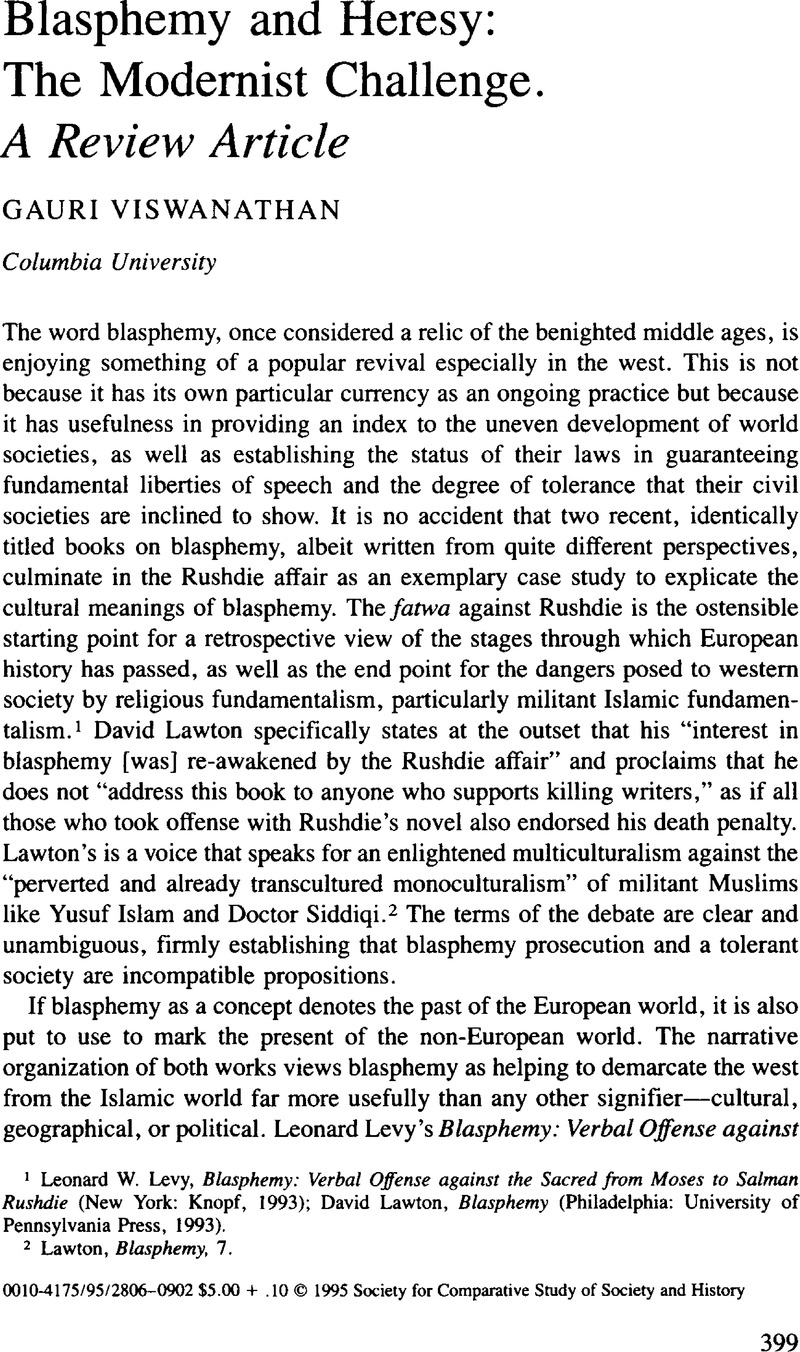Article contents
Blasphemy and Heresy: The Modernist Challenge. A Review Article
Published online by Cambridge University Press: 03 June 2009
Abstract

- Type
- CSSH Discussion
- Information
- Copyright
- Copyright © Society for the Comparative Study of Society and History 1995
References
1 Levy, Leonard W., Blasphemy: Verbal Offense against the Sacred from Moses to Salman Rushdie (New York:Knopf, 1993);Google ScholarLawton, David, Blasphemy (Philadelphia:University of Pennsylvania Press, 1993).Google Scholar
2 Lawton, , Blasphemy, 7.Google Scholar
3 Carter, Stephen, The Culture of Disbelief: How American Law and Politics Trivialize Religious Devotion (New York:Basic Books, 1993).Google Scholar See also Asad, Talal, Genealogies of Religion: Discipline and Reasons of Power in Christianity and Islam (Baltimore:The Johns Hopkins University Press, 1993), for a powerful criticique of secular culture, Islam, and modernity.Google Scholar
4 Kuhn, Thomas, The Structure of Scientific Revolutions, 2d ed. (Chicago:University of Chicago Press, 1970).Google Scholar See also Banner, Michael C., The Justification of Science and the Rationality of Religious Belief (Oxford:Clarendon Press, 1990), which extends Kuhn's understanding of how interpretive communities govern scientific knowledge to a consideration of the controlled growth of religious knowledge. One of the more interesting series on television to appear in recent years, the British Broadcasting Corporation's program, “Heretics,” employs the language of religious heresy to describe scientific innovation and its resistance by mainstream establishments.Google Scholar
5 Lawton, , Blasphemy, 179.Google Scholar The cited text of Bhabha, Homi is the essay “DissemiNation: Time, Narrative, and the Margins of the Modern Nation,” in Bhabha, Homi, ed., Nation and Narration (London:Routledge), 291–322.Google Scholar
6 Kee, Howard Clark, “From the Jesus Movement toward Institutional Church,” Hefner, Robert W., ed., Conversion to Christianity: Historical and Anthropological Perspectives on a Great Transformation (Berkeley:University of California Press, 1993), 47–64.Google Scholar
7 Levy, , Blasphemy: Verbal Offense, 32.Google Scholar
8 Thomas, Stephen, Newman and Heresy (Cambridge:Cambridge University Press, 1991), 3.CrossRefGoogle Scholar
9 Levy, , Blasphemy: Verbal Offense, 484.Google Scholar See also Toohey, Timothy J., “Blasphemy in Nineteenth-Century England: The Pooley Case and Its Background,” Victorian Studies, 30:3 (1987), 315–33. Arguing that the Pooley case became a crucial test case for distinguishing between rationality and eccentricity as the bases of the freedom of expression, Toohey's essay moves toward the conclusion that, after the Pooley case, “England slowly moved out of an age when men were successfully prosecuted for blasphemy. If sane they were reasonable enquirers, if insane they needed treatment” (p. 316).Google Scholar
10 Quoted in Levy, Blasphemy: Verbal Offense, 484.Google Scholar
11 Lawton, , Blasphemy, 120.Google Scholar
12 Pattison, Robert, The Great Dissent: John Henry Newman and the Liberal Heresy (New York:Oxford University Press, 1991), 6.CrossRefGoogle Scholar
13 Kurtz, Lester, The Politics of Heresy: The Modernist Crisis in Roman Catholicism (Berkeley:University of California Press, 1986), 147.Google Scholar
14 Eliot, T. S., The Idea of a Christian Society, and Other Writings (1939; rpt., London:Faber and Faber, 1982), 54–55.Google Scholar See also his After Strange Gods (London:Faber and Faber, 1934).Google Scholar
15 Locke, John, A Letter Concerning Toleration, Tully, James, ed. (1689; rpt., Indianapolis:Hackett Publishing Co., 1983), 46.Google Scholar
16 The Works of Lord Macaulay, Trevelya, Lady, ed. (London, 1866, 8 vols.), vol. 8, speech of April 17, 1833, pp. 104–5; quoted in Levy, Blasphemy: Verbal Offense, 494.Google Scholar
17 See Newma's, An Essay in Aid of A Grammar of Assent (Notre Dame:University of Notre Dame Press, 1979) for an elaboration of belief as critical practice.Google Scholar
18 Nandy, Ashis, “The Politics of Secularism and the Recovery of Religious Tolerance,” Mirrors of Violence: Communities, Riots, and Survivors in South Asia, Das, Veena, ed. (Delhi:Oxford University Press, 1990), 70.Google Scholar
19 Levy, , Blasphemy: Verbal Offense, 566.Google Scholar
20 Ibid.,
21 King, Preston, Toleration (London:George Allen and Unwin Ltd., 1976), 25.Google Scholar
- 2
- Cited by


